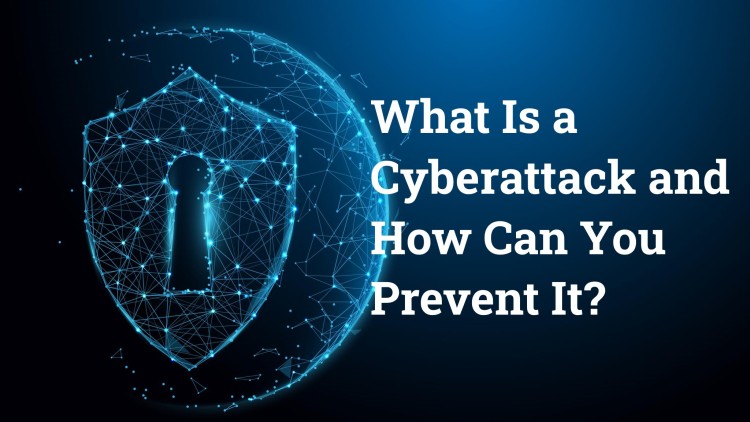What Is a Cyberattack and How Can You Prevent It?

In this digital era, the internet is the most powerful tool that can benefit individuals by providing instant access to everything. It's how businesses or companies grow and innovate faster. As businesses or companies expand, they require a larger number of employees with computers and other resources that need to be connected to the internet. Connecting to the internet carries a high risk of allowing unauthorized access to your computers, online accounts, profiles, or even important documents that must be kept private. It's as if you are creating a gateway for individuals to access your business or company, but you cannot guarantee that unauthorized persons won't gain entry, which measures the vulnerability of your business or company.
What Is a Cyberattack?
A cyberattack is an attempt by unauthorized individuals to gain access to computers and networks with malicious intentions to harm others, such as businesses or companies. These unauthorized individuals may steal information, damage computer systems, and, most importantly, cause chaos online that can affect the reputation of those affected. It's like someone breaking into your home, but instead of using a physical entrance, they use their computer skills to infiltrate your digital life.
Cyberattacks are online crimes that target individuals, businesses, companies, or even entire countries. These attacks can take various forms, such as hacking into computer systems to steal important information, launching viruses or malware to disrupt operations, or attempting scams through phishing emails and websites.
Different Types of Cyberattacks and How to Prevent Them
• Malware
- Malware, short for "malicious software," is like a covert computer program with malicious intentions that infiltrates your computer system without your permission. This program can damage or disable your computer, smartphone, and tablet systems. Malware can be introduced through suspicious websites, email attachments, seemingly harmless downloads, or even via connected USB devices, potentially leading to issues like data theft or file damage.
- To prevent this cyberattack, follow these tips:
- Use antivirus software.
- Keep your computer software updated.
- Download from trusted sources.
- Enable computer system firewalls.
- Use strong and unique passwords.
- Enable two-factor authentication.
- Regularly scan for malware on your devices.
• Phishing
- Phishing is a type of social engineering used to deceive users by pretending to be trustworthy and coaxing them into revealing sensitive information, such as passwords, credit card numbers, or social security details. This attack is often delivered through fake messages or emails aimed at stealing personal information or money.
- To prevent this cyberattack, follow these tips:
- Be skeptical of unsolicited emails or messages.
- Verify the sender's identity.
- Avoid clicking on suspicious links.
- Verify requests for your personal information.
• Denial-of-Service (DoS)
- A Denial-of-Service (DoS) attack aims to create an internet traffic jam, potentially damaging a computer system by rendering it unavailable to legitimate users. It's like overwhelming a website or service with fake traffic, causing problems in responding to requests from regular users. These attacks are typically orchestrated by cybercriminals to inconvenience or harm businesses or companies.
- To prevent this cyberattack, follow these tips:
- Use DoS mitigation services provided by cloud security.
- Implement network monitoring to detect unusual traffic patterns.
- Employ load balancers to distribute incoming traffic across multiple servers.
- Collaborate with your internet service provider (ISP) to implement traffic filtering.
• Man-in-the-Middle Attack
- Man-in-the-middle attacks intercept the communication between two or more parties in order to steal or manipulate information exchanged. It's akin to someone secretly eavesdropping on or altering your conversations with friends over the internet. Cybercriminals can access your private information, such as login details and device activity, manipulating it without your knowledge to steal information or trick you into inappropriate actions.
- To prevent this cyberattack, follow these tips:
- Always look for the secure URL "https://" when visiting websites.
- Verify website certificates.
- Use strong and unique passwords.
- Exercise caution when using public Wi-Fi networks.
• Zero-day Attack
- A zero-day attack is one of the most challenging attacks to defend against. It exploits vulnerabilities in software before developers have a chance to address them. Hackers discover weaknesses in computer software, leveraging them to infiltrate computers, steal information, and cause damage. It's called a "zero-day" attack because developers have zero days to fix the issue before hackers exploit it.
- To prevent this cyberattack, follow these tips:
- Keep your software updated.
- Use security software such as antivirus and anti-malware tools.
- Implement network security measures like firewalls.
- Consider using application whitelisting.
Conclusion
Cyberattacks are indeed battles in the digital world and can have serious consequences. When individuals, businesses, companies, or entire countries fall victim to cyberattacks, they can lose money, customers, and their hard-earned reputation. Being aware of the risks and taking proactive steps to protect against cyberattacks is crucial. Just as we lock our doors and secure our homes, in the digital realm, having strong passwords, keeping software updated, and exercising caution online are like building strong defenses. By staying informed and practicing good cybersecurity habits, we can guard against these digital threats and safeguard our digital lives.
